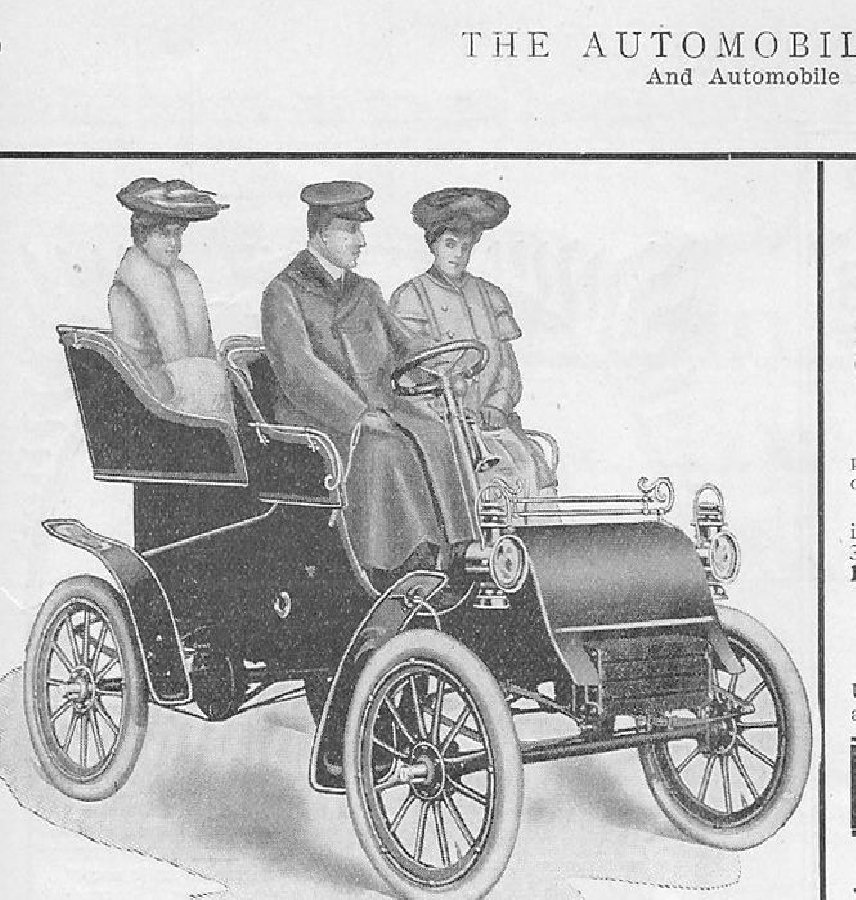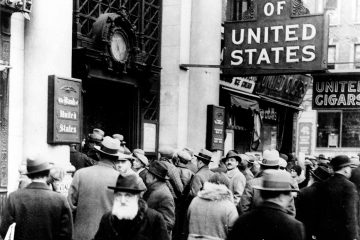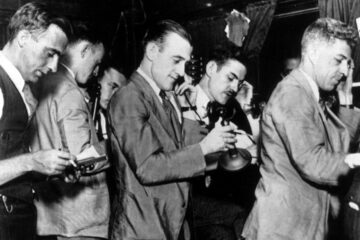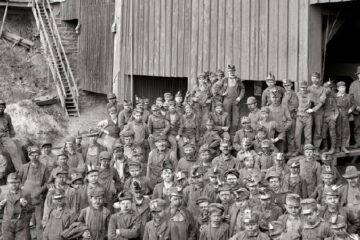What Happened in Business: 1903
| « 1902 | 1904 » |
 Summary: Growth Year ꜛ, Mix Challenges
Summary: Growth Year ꜛ, Mix Challenges
U.S. President: Theodore Roosevelt
DJIA End of Year Close: 49.11
Top Stocks: United States Steel Corporation, American Tobacco Company, American Sugar Refining Company*
Media: Newspaper, Mail, Magazine, Telegraph, Posters, Catalogs, Typewriters, Photography, Telephone
Wealthiest American: John D. Rockefeller
U.S. Population: 80.6 million (est)
Era: Progressive Era (1890s–1920s)
Key Events & Dates
Wright Brothers’ First Powered Flight – December 17, 1903:
Orville and Wilbur Wright achieved the first powered, controlled, and sustained flight in Kitty Hawk, North Carolina, marking a significant milestone in aviation history.
First Original Ford Model A Produced – July 23, 1903:
The Ford Motor Company produced its first car, the Model A, marking the beginning of Henry Ford’s influence on the American automobile industry.
Hay-Bunau-Varilla Treaty of 1903:
In 1903, the United States negotiated a treaty with Panama to build the Panama Canal. The treaty gave the United States a 10-mile wide strip of land for the canal, a one-time $10 million payment, and an annual annuity of $250,000. The United States also agreed to guarantee Panama’s independence.
Rich Man’s Panic of 1903:
The panic began with a sharp drop in stock prices in March 1903. Over the following months, the market continued to suffer. One of the pivotal moments was the near-collapse of the Northern Pacific Railway, which had been overleveraged and overbuilt.
First Cross-Country Automobile Trip – July 23, 1903:
H. Nelson Jackson and Sewall K. Crocker completed the first documented cross-country automobile trip from San Francisco to New York City, demonstrating the potential of automobiles for long-distance travel.
Opening of the Williamsburg Bridge – December 19, 1903:
The Williamsburg Bridge in New York City was opened, enhancing transportation and connectivity for businesses and commuters.
First World Series Baseball Game – October 1, 1903:
The first modern World Series baseball game took place, becoming a significant event in the sports and entertainment industry.
Opening of the New York Stock Exchange (NYSE) Building – April 22, 1903:
The NYSE opened its new building at 18 Broad Street in New York City, reflecting the importance of the stock market in American business.
First Automated Luggage Conveyor System – 1903:
The first automated luggage conveyor system was introduced at the Grand Central Terminal in New York City, improving efficiency for travelers and businesses.
Rise of Labor Unions – Early 1900s:
Labor unions, including the United Mine Workers and American Federation of Labor, gained strength and influence, impacting labor relations and workplace conditions.
U.S. Economic Landscape in 1903
The U.S. economic landscape in 1903 was characterized by a mix of growth and challenges, reflecting the complexities of the early 20th-century industrial economy. Here’s an overview of the key aspects of the U.S. economy during that year:
Industrial Expansion
Continued Growth: Despite economic challenges, industries such as steel, oil, and manufacturing continued to grow. The U.S. was solidifying its position as a leading industrial power.
Technological Innovations: Advancements in technology, notably in transportation (automobiles, railroads) and communication (telephony), were driving economic growth.
Financial Sector
Stock Market Fluctuations: The year began in the aftermath of the Rich Man’s Panic of 1903, a financial crisis that caused significant stock market volatility.
Banking Challenges: The financial sector faced challenges due to the panic, including bank failures and a lack of federal regulatory mechanisms that would only come with later reforms.
Labor and Employment
Labor Disputes: The period saw significant labor unrest, with workers increasingly organizing for better wages, hours, and working conditions.
Emergence of Unions: Labor unions were becoming more influential, though they faced opposition from businesses and government entities.
Agriculture
Rural Economy: Agriculture remained a significant part of the economy, though farmers faced issues like price volatility and debt.
Migration: There was a continuing trend of migration from rural areas to cities as people sought industrial and manufacturing jobs.
Business Environment
Rise of Big Business: Large corporations and trusts, particularly in industries like steel (U.S. Steel Corporation) and oil (Standard Oil), dominated the business landscape.
Antitrust Sentiment: There was growing public and governmental concern over the power of monopolies and trusts, leading to calls for regulation.
International Trade
Expanding Trade: The U.S. continued to expand its international trade, exporting goods such as machinery, agricultural products, and raw materials.
Panama Canal: The ongoing efforts to build the Panama Canal (Hay-Bunau-Varilla Treaty signed in 1903) were significant for future trade prospects.
Transportation and Infrastructure
Railroads: The railroad industry, despite facing challenges, remained a crucial part of the economy, both for transportation and as a major area of investment.
Emergence of Automobiles: The automotive industry began to emerge as a significant sector, particularly with the founding of the Ford Motor Company in 1903.
Socioeconomic Issues
Wealth Disparity: There was a significant disparity in wealth and living conditions, with a growing middle class but also widespread poverty, particularly in urban areas.
Progressive Movement: The era saw the beginnings of the Progressive Movement, aiming to address issues like poverty, labor rights, and corporate monopolies.
The economic landscape of 1903 in the U.S. was thus marked by dynamic industrial growth, financial instability, labor struggles, and the beginnings of regulatory and social reforms.
Consumer Brands of the Era
In the year 1903, the United States had several consumer brands that were well-established or emerging. Here are a few notable consumer brands from that era:
Coca-Cola: Coca-Cola was already gaining popularity as a soft drink in the United States. It was initially created in the late 19th century but had become more widely available by 1903.
Ivory Soap: Procter & Gamble’s Ivory Soap was a well-known brand of soap in 1903. It was marketed as a pure and gentle soap, and its marketing emphasized its purity.
Quaker Oats: The Quaker Oats Company was manufacturing and selling oatmeal and other cereal products. Their brand featured the famous image of the Quaker Oats man on its packaging.
Hershey’s Chocolate: The Hershey Chocolate Company, founded by Milton Hershey, was producing Hershey’s milk chocolate bars and other confectionery products.
Arm & Hammer: Arm & Hammer, known for its baking soda, was a recognized brand in households across the United States. Baking soda had various uses, including cleaning and cooking.
Jell-O: The Jell-O brand, offering various flavored gelatin desserts, was growing in popularity during this time period.
Campbell’s Soup: Campbell’s was already producing canned soups and had introduced its iconic red and white label.
Heinz: H.J. Heinz Company, known for its ketchup and other condiments, had been in operation for several decades by 1903 and was a trusted brand in American kitchens.
Colgate: The Colgate-Palmolive Company was producing toothpaste and other personal care products under the Colgate brand.
These brands reflect the changing consumer landscape of the early 20th century, with an emphasis on convenience, purity, and new food and household products. Many of these brands have continued to thrive and evolve over the decades, becoming household names in the United States and beyond.
Key Leaders, Innovators, & Influencers of the Era
In 1903, several important business leaders and influencers were instrumental in shaping the American business landscape. Here are some notable individuals:
John D. Rockefeller:
John D. Rockefeller was a prominent industrialist who had made his fortune in the oil industry. He was a key figure in the Standard Oil Company, which controlled a significant portion of the oil market.
J.P. Morgan:
J.P. Morgan was a powerful financier and banker. His firm, J.P. Morgan & Co., played a crucial role in financing major corporations and consolidating industries, including the formation of U.S. Steel.
Andrew Carnegie:
Andrew Carnegie was a steel magnate and philanthropist. While he had sold Carnegie Steel to J.P. Morgan in 1901, he remained an influential figure and a major philanthropist.
James B. Duke:
James B. Duke was a tobacco and electric power magnate. He controlled the American Tobacco Company and was involved in the development of the electric power industry.
Henry Ford:
Although not yet widely known, Henry Ford was making significant advancements in automobile manufacturing in 1903. His development of the Model A and the eventual introduction of the Model T revolutionized the automotive industry.
George Westinghouse:
George Westinghouse was an inventor and entrepreneur known for his contributions to the development of the electric power industry. His company, Westinghouse Electric Corporation, was a major player in electrical technology.
Thomas Edison:
Thomas Edison, while less active in the business world by 1903, was already known for his inventions and innovations, including the development of the electric light bulb.
Guglielmo Marconi:
Guglielmo Marconi was an Italian inventor and entrepreneur who made significant contributions to the development of wireless telegraphy. In 1902, he successfully transmitted the first transatlantic wireless telegraph message.
James J. Hill:
James J. Hill was a railroad executive and the driving force behind the Great Northern Railway. He played a crucial role in the expansion of railroads in the American West.
These business leaders and influencers were instrumental in shaping various industries, including oil, steel, finance, transportation, technology, and tobacco, during the early 20th century. Their actions and innovations had a lasting impact on the U.S. economy and business landscape.
* Stocks are examples of some of top, popular traded stocks; however, exact data not available.
| « 1902 | 1904 » |


